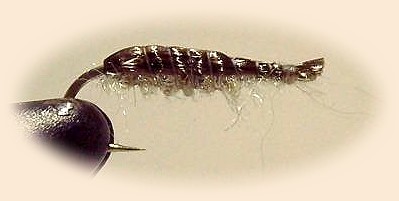|
Although Fox Statler is called "Mr. Sowbug", he
really uses a scud almost all the time. The
reason he says is a matter of "preference". Not
his own preference but the preference of the trout
in the White River System in Arkansas and Missouri
and any other river, stream, spring creek or lake
where it is present. To explain this he tells one
of his many stories.
"Several years ago, in the early '70's, I moved to
the Mountain Home which is in the Ozark Mountains
of Arkansas. I was a math teacher and then as still
now, Arkansas teachers weren't paid very much. I
made $9,100 that year. I had four children, a wife
that worked, a college degree, and we qualified for
food stamps. I was too proud to take the food stamps
so I supplemented our groceries by hunting and
flyfishing. I spent every day I wasn't teaching with
a gun or a fly rod in my hand. In those days, I practiced
"catch and feed the kids", not C&R. This was true of most
everyone on the river back then, most of whom were bait
guides. In fact, when I started to guide the rivers,
John Gulley was the only real full time flyfishing guide
I knew of. Some said they were, but I never saw any of
them with a fly rod in their hand.
John and most everyone else that came to the rivers
were woolly bugger fisherman and I hated woolly buggers.
To me, woolly buggers were, and still are, a poor
imitation of a lot of things and a good imitation
of nothing. I had already developed the Arkansas
Dead-Drift and sowbugs were about all the flies I
carried except for a couple scuds. You see, the
sowbugs were so thick back then, that if you stood
still for two minutes you couldn't find the toes of
your boots. And that's not an exaggeration.
One day, I decided to dig up one square yard of gravel
near Bull Shoals Dam and collect every aquatic insect
in it. Being a math teacher, numbers were and still
are pure logic in the raw to me. I found that there
were about 7,000 sowbugs, 500 scuds, 100 planarian, 3
mayflies, and 1 caddis per square yard of gravel. Well
to me this represented the ratio of bites that I could
expect using any of these bugs. While the ratio of
bites of sowbugs to planaria, to mayflies, to caddis
was true. The ratio of sowbugs to scuds wasn't. You
see there were 14 sowbugs to every scud, but in the
fish's stomach the ratio was 5 sowbugs to 1 scud, or
4 to 1, and sometimes 3 to 1. I wanted to find the
reason why this was happening. I thought I knew the
answer but I wanted proof from a reliable source before
I started spouting off. I searched for the answer to
my paradox for almost a year.
Near the end of the school year, the junior high science
teachers organized a field trip to Blanchard Springs
Caverns. I drove the bus so I had to go. Before each
group of students went down into the caverns, they had
to attend a short 30 minute movie and lecture. As my
group was leaving, I noticed two large sketchings on
the wall, one of a sowbug and the other of a scud.
They caught my attention because both drawings were
about a foot long with infinite detail. As I was
admiring someone's else artistic abilities, which I
lacked, the young Speleologist who gave the lecture
ask me if I knew what I was looking at. I told her
I sure did and probably played with them more than
anyone she had ever met. She proceeded to tell me a
whole lot about them anyway. A lot I already knew but
some I didn't. Then I told her about my ratio problem.
She smiled at me and said that was simple. She said
the first thing you do when exploring a cave is to figure
the bio-mass, then you would kind of have an idea of what
to expect. Then she threw me the bomb. She said that
scuds have five times more protein than sowbugs, and the
fish's instincts tell them to eat the best food available
at all times. To me that meant that a trout would pass up
9 sowbugs to eat one scud.
The answer was what I had expected, and, from the day
I had dug up that one square yard of gravel, I had been
fishing scuds with great success. But thanks to 5 foot
blonde genius, I knew for sure why I was succeeding.
She don't know how close I came to giving her a big
old hug and kiss that day. But...I decided to not
show her how jubilant I felt... because I wanted to
see the caverns and not the insides of a jail."
How To Tie Fox's Arkansas Scud
A scud can come in several colors, even within the
same river, because of the life-cycle stage it is
in and what it eats. A scud may molt from one to
several times a year depending upon the water
temperature and how fast it is growing. A
young-of-the-year scud may molt several times in
the summer while an adult may molt only once. Just
before a scud molts, it turns very dark in color and
moves to fine gravel to bury itself. This may be a
dark chocolate, dark olive, or dark gray (almost black).
During the molt, it looses its outside skeleton or shell
and grows another. The coloring of its new shell is pale
yellow to a pale yellow-green. About the time it leaves
its hiding spot, it may be a copper, light olive, or pale
gray. As the new shell ages and hardens, its coloring
will darken to almost the colors of the river bottom. It
is suggested by Fox to use a shade darker than a molting
scud or a molting scud color. Rarely does he use the dark
phase. Why, because Fox thinks the fish prefer the more
easily digestible lighter phase over the darker phase.
So even though these are very good colors to start with,
he suggests that you "tune" your scud pattern to the water
you are fishing.
The Hook
Your choice of hook can make a lot of difference in
the amount of success you experience when fishing a
scud. A straight-eyed, fine wire, quality dry fly
hook has proven to be the best. Circle hooks and
rounded shank hooks imitate resting scuds, while
straight shank hooks imitate swimming scuds. A
straight-eyed, straight shank hook offers the largest
hook gape for that size of hook and will have the best
hook set. A fine wire hook will penetrate the flesh
and bone of a fish's mouth with less effort than a
heavy nymph wire hook. This is especially helpful
when using tippets of 6x and smaller.
The Lead
The size of lead used in this scud pattern is
related to the size of hook to be used. On a
#12 hook use .025" lead wire, #14 hook use .020",
#16 hook use .015", and on a #18 hook use .010".
For scuds smaller than #18, try the Worm Scud
Pattern, another article on this site. Always
wrap enough lead wire to fill half of the hook-shank,
usually this is about 8 to 10 wraps depending upon
your choice of hook.
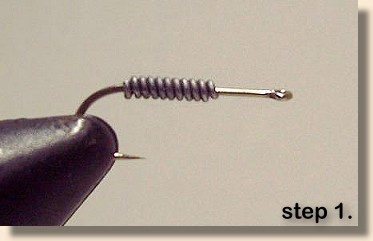
The Thread
The thread of your pattern (#8/0) can help you catch
more fish by highlighting the scud the right way in
the right conditions. For an early morning (dawn)
and late evening (dusk) scuds use fluorescent orange
or fluorescent red thread. For high-noon (bright days)
scuds use light blue thread. For day scuds use the
thread that best matches the coloring of the segment
edges of the scud's body in the water you are fishing.
This could be pink, yellow, or cinnamon on molting scuds,
camel, insect green, or iron gray for adult scuds.
Take your thread and capture the lead at the bend of
the hook to the middle of the shank. Build up the
thread at the front of the lead to make a smoother
transition from the hook shank diameter to the lead
diameter. End this step with the thread on the lead.
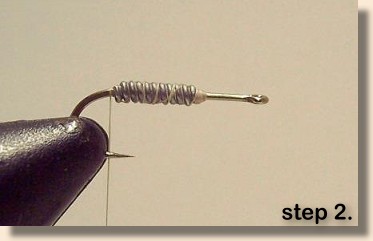
The Straw
Swiss straw is too wide as it is sold. Cut a piece
about 4 to 8 inches long and then split it with a
sharp knife or razor blade into 1/4 inch to 3/16 inch
strips. The wider strips work well for #12 and #14
scuds and the smaller for #16 and #18 scuds. Place
the swiss straw over the lead and wrap it down. End
with the thread at the hook-eye.
The reason for tying the straw in before the dubbing
is to make the pattern more durable. Most bugs come
undone at the rear end, this is true of scuds also.
By tying the straw in now, the straw will have to
wear-in-two and not come untied.
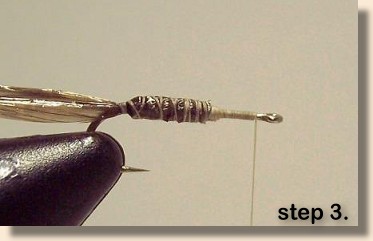
The Dubbing
The dubbing of a scud is so important. Your dubbing
needs to be the correct leg length when it sticks to
the waxed thread, the right color, and it doesn't
hurt for the mixture to have some light reflecting
abilities. Adding some Zelon to any mixture is
helpful, but using a mixture of antron and zelon
has proven to be the best over the years. Make
sure you chop your mixture to about 1/8 inch long
before blending it. Then when you "touch dub"
(dabbing the dubbing to the waxed thread) it will
put a uniform layer of dubbing on your thread.
Dub the scud from the hook-eye to the hook-bend
placing an even layer of dubbing on the entire pattern.
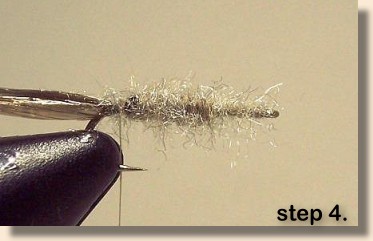
Flatten Now
This step is hard to show with a photograph, but
the scud below has been flattened vertically with
a pair of flat-nosed pliers. Now is the time to
flatten the scud before the back is tied down.
If you flatten the scud after the back is on, it
will often split the back ruining the pattern.
Don't flatten the scud with a lot of force.
Excessive force will cause the lead wire to be
cut by the hook-shank and the scud will fall apart.
The flattening of the lead gives the pattern a little
curve to the body by making the fly fatter at the
hook-bend than at the hook-eye.

The Back
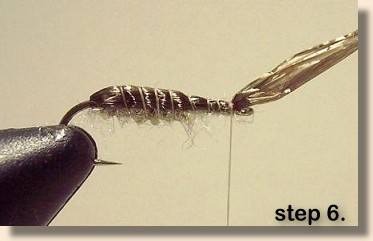
Giving the back a smooth appearance involves more
than just winding the thread over it. First the
straw should be opened as wide as possible and
then pulled toward the hook-eye as it is wrapped
down. With a little practice, this step becomes
quite easy. Whip finish with just three wraps.
Trim the straw just in front of the hook-eye
leaving a short tail.
The Gluing
The glue used for coating the back of the fly is
a mixture of one part glue (head cement or "Sally
Henson's Hard-As-Nails") and two parts thinner.
Why do you want to use a diluted mixture of glue?
Because you don't want the glue to build up on the
straw but penetrate the straw and dubbing to the
lead wire. This will make the straw and the entire
scud very durable. To save time when making scuds,
you can hook them on a piece of Styrofoam or foam
tape and glue several at once.
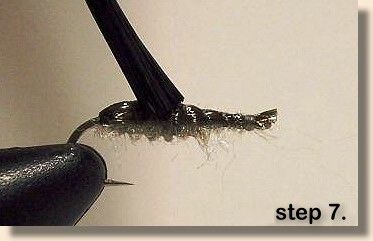
The Finished Scud
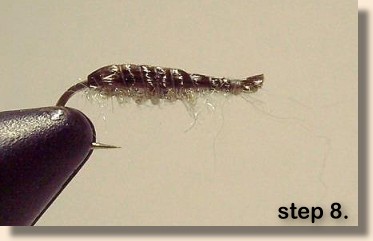
Fox's Arkansas Scud is a two minute fly. Actually he
ties it in about 1 minute and 40 seconds while he
babbles away about some monster brown that was caught
in the past. He calls it a "guide's fly" because it
is easy to tie but extremely effective. This pattern
has been fished in most trout rivers of the United States
and several international rivers in Argentina and New
Zealand with much success.
The Variations
As mentioned earlier, the variations to this pattern
are countless. Below in the upper left hand corner
is a copper molting scud, then a dark gray in the
upper right, a Brookville or tan scud in the center,
lower left is a dark olive, and lower right is a medium
red brown. Remember to "tune" your fly to the match the
scuds in the water your are fishing. With a little
experience it won't take long to make an educated guess
about the color of scuds in a particular river just by
looking at a picture of the river bottom.
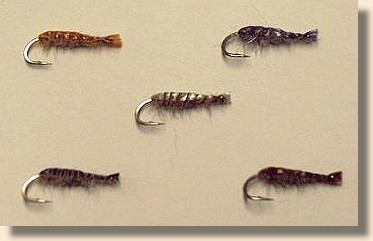
This year, 2008, this pattern is being commercially
tied by Targus in several color combinations and
sizes. We are thankful for Targus's interest in
Fox's Arkansas Scud, a tested standard of nymph anglers. ~ Fox Statler, Salem, AR
For more great flies, check out:
Beginning Fly Tying,
Intermediate Fly Tying and Advanced
Fly Tying.
|

